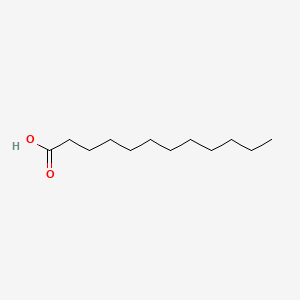| MeSH term | MeSH ID | Detail |
|---|---|---|
| Acne Vulgaris | D000152 | 35 associated lipids |
| Albuminuria | D000419 | 18 associated lipids |
| Bird Diseases | D001715 | 4 associated lipids |
| Body Weight | D001835 | 333 associated lipids |
| Cell Transformation, Viral | D002472 | 26 associated lipids |
| Cerebral Infarction | D002544 | 6 associated lipids |
| Cerebrovascular Disorders | D002561 | 25 associated lipids |
| Colonic Neoplasms | D003110 | 161 associated lipids |
| Cystic Fibrosis | D003550 | 65 associated lipids |
| Diabetes Mellitus, Experimental | D003921 | 85 associated lipids |
lauric acid
lauric acid is a lipid of Fatty Acyls (FA) class. Lauric acid is associated with abnormalities such as Infection, Renal tubular disorder, Hypertensive disease, Obesity and Mycoses. The involved functions are known as Transcription, Genetic, Signal Transduction, Mutation, metaplastic cell transformation and Anabolism. Lauric acid often locates in Skin, Plasma membrane, Cytoplasmic matrix, Body tissue and Palmar surface. The associated genes with lauric acid are Gene Family, SLC33A1 gene, Homologous Gene, Open Reading Frames and P4HTM gene. The related lipids are Fatty Acids, Oleic Acids, Palmitates, Stearates and 9,11-linoleic acid.
Cross Reference
Introduction
To understand associated biological information of lauric acid, we collected biological information of abnormalities, associated pathways, cellular/molecular locations, biological functions, related genes/proteins, lipids and common seen animal/experimental models with organized paragraphs from literatures.
What diseases are associated with lauric acid?
lauric acid is suspected in Renal tubular disorder, Hypertensive disease, Infection, Renal vascular disorder, Obesity, Mycoses and other diseases in descending order of the highest number of associated sentences.
Related references are mostly published in these journals:
| Disease | Cross reference | Weighted score | Related literature |
|---|
Possible diseases from mapped MeSH terms on references
We collected disease MeSH terms mapped to the references associated with lauric acid
PubChem Associated disorders and diseases
What pathways are associated with lauric acid
There are no associated biomedical information in the current reference collection.
PubChem Biomolecular Interactions and Pathways
Link to PubChem Biomolecular Interactions and PathwaysWhat cellular locations are associated with lauric acid?
Visualization in cellular structure
Associated locations are in red color. Not associated locations are in black.
Related references are published most in these journals:
| Location | Cross reference | Weighted score | Related literatures |
|---|
What functions are associated with lauric acid?
Related references are published most in these journals:
| Function | Cross reference | Weighted score | Related literatures |
|---|
What lipids are associated with lauric acid?
Related references are published most in these journals:
| Lipid concept | Cross reference | Weighted score | Related literatures |
|---|
What genes are associated with lauric acid?
Related references are published most in these journals:
| Gene | Cross reference | Weighted score | Related literatures |
|---|
What common seen animal models are associated with lauric acid?
There are no associated biomedical information in the current reference collection.
NCBI Entrez Crosslinks
All references with lauric acid
Download all related citations| Authors | Title | Published | Journal | PubMed Link |
|---|---|---|---|---|
| Parrish JM et al. | Haloacetate-induced oxidative damage to DNA in the liver of male B6C3F1 mice. | 1996 | Toxicology | pmid:8658551 |
| Clementz T et al. | Function of the htrB high temperature requirement gene of Escherichia coli in the acylation of lipid A: HtrB catalyzed incorporation of laurate. | 1996 | J. Biol. Chem. | pmid:8662613 |
| Bekkers AC et al. | Targeting of porcine pancreatic phospholipase A2 to human platelets. Introduction of an RGD sequence and acyl-group by chemical modification. | 1996 | Eur. J. Biochem. | pmid:8665954 |
| Charbon V et al. | Targeting of drug to the hepatocytes by fatty acids. Influence of the carrier (albumin or galactosylated albumin) on the fate of the fatty acids and their analogs. | 1996 | Pharm. Res. | pmid:8668674 |
| Sherrington EJ et al. | Lack of effect of different dietary saturated fatty acids on adipose tissue deposition in the rat. | 1996 | Biochem. Soc. Trans. | pmid:8736816 |
| Byard J et al. | Novel approaches to the purification and identification of cytochrome P450 enzymes in the equine. | 1996 | Biochem. Soc. Trans. | pmid:8736866 |
| von Wichert P et al. | Increased incorporation of fatty acids into phospholipids of lungs and livers of rabbits under the influence of bromhexine and ambroxol. | 1977 | Naunyn Schmiedebergs Arch. Pharmacol. | pmid:876401 |
| Tanaka K et al. | Enhancement of intestinal transport of thyrotropin-releasing hormone via a carrier-mediated transport system by chemical modification with lauric acid. | 1996 | Biochim. Biophys. Acta | pmid:8765103 |
| Saito M et al. | 2-(5-hydrazinocarbonyl-2-oxazolyl)-5,6-dimethoxybenzothiazole as a precolumn fluorescence derivatization reagent for carboxylic acids in high-performance liquid chromatography and its application to the assay of fatty acids in human serum. | 1995 | J. Chromatogr. B, Biomed. Appl. | pmid:8788145 |
| Godet MC et al. | Inclusion/exclusion of fatty acids in amylose complexes as a function of the fatty acid chain length. | 1995 | Int. J. Biol. Macromol. | pmid:8789347 |
